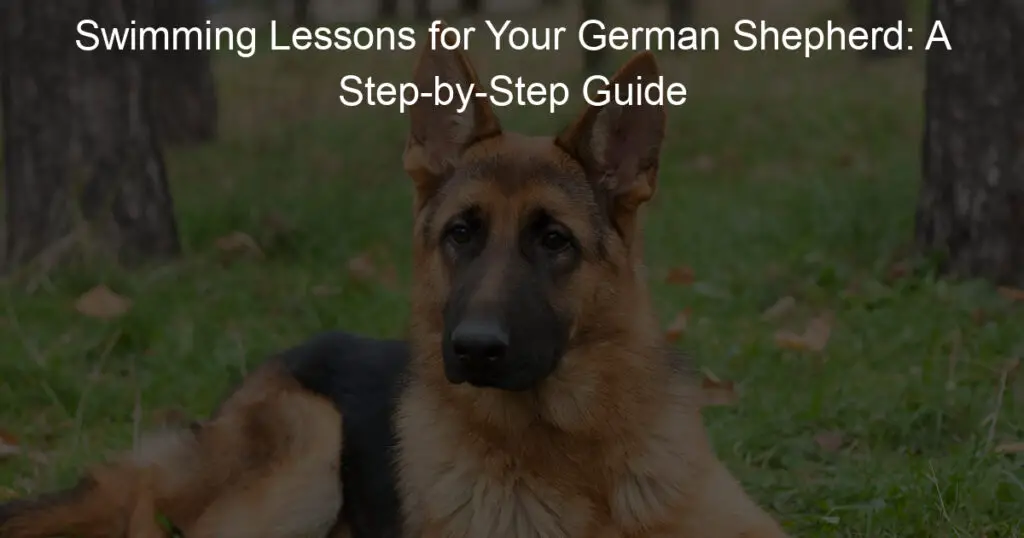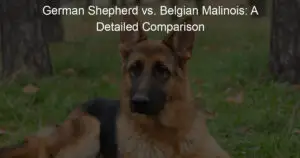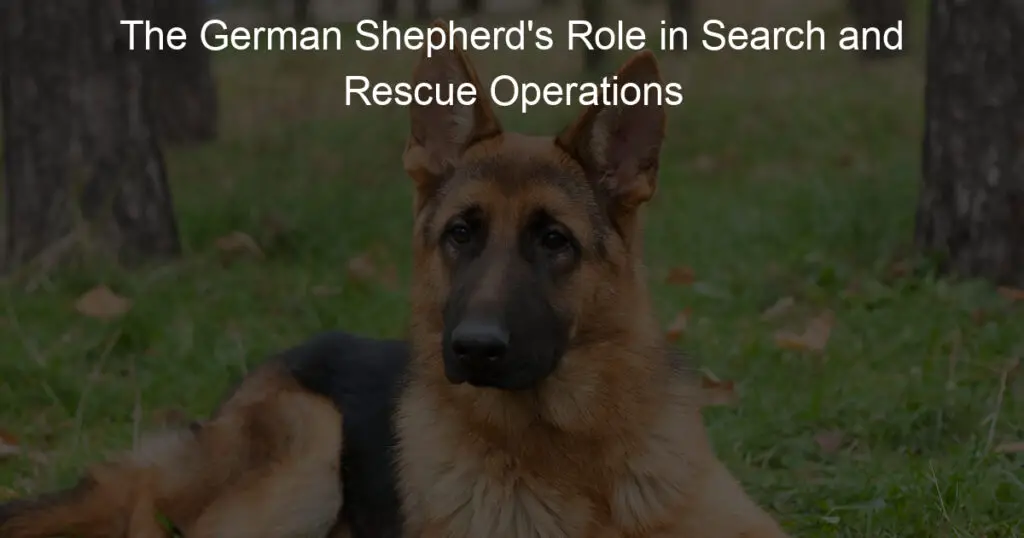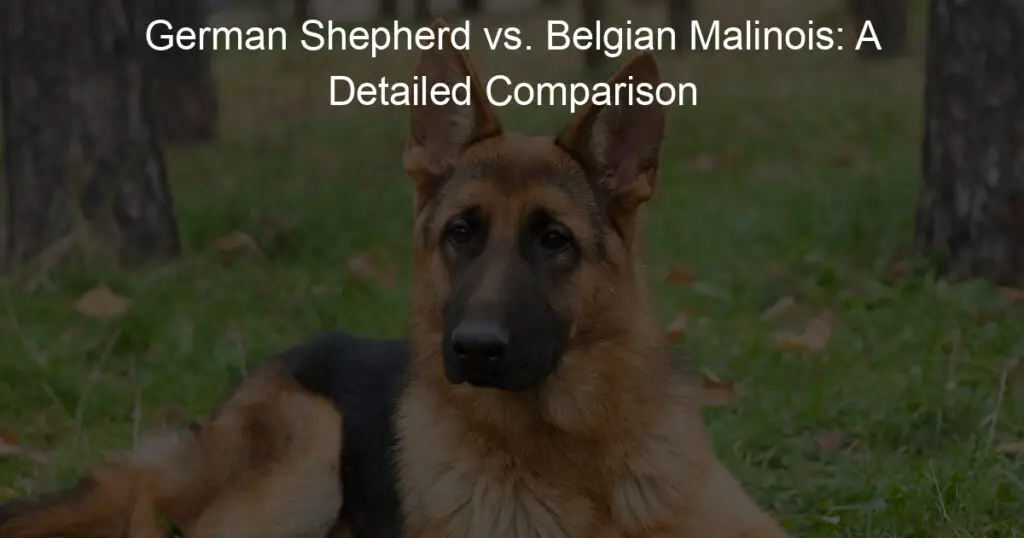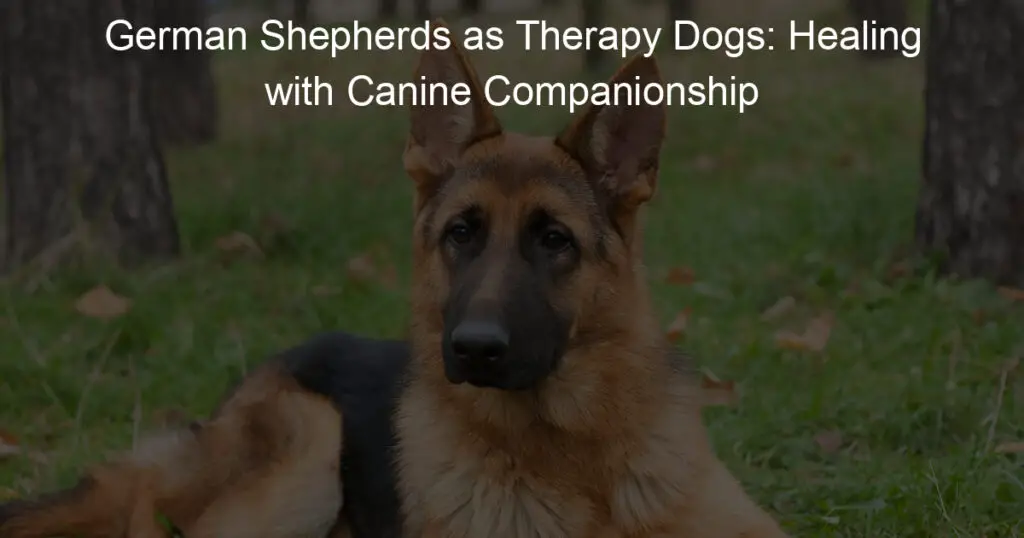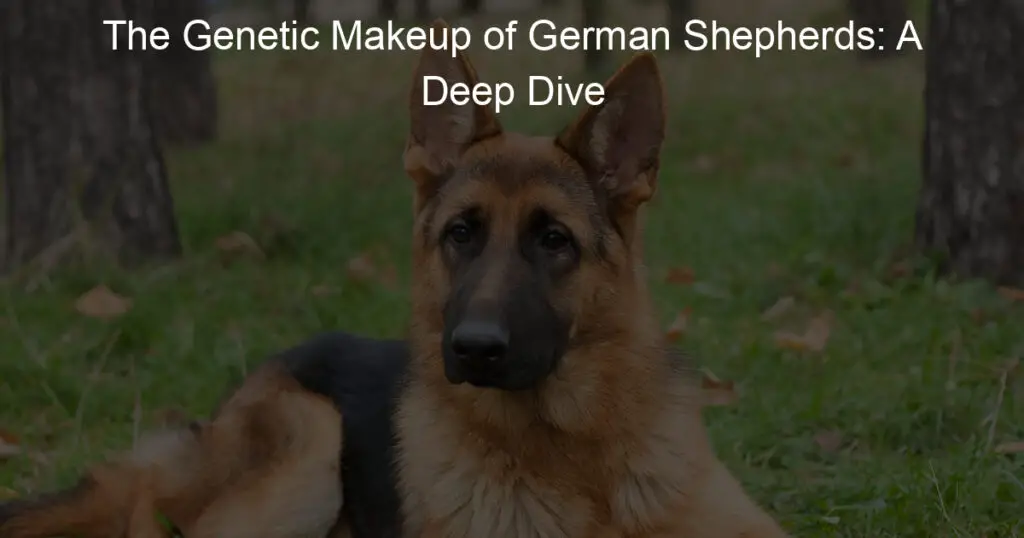Ensure your German Shepherd's safety and fitness with swimming lessons. This blog post offers a detailed, step-by-step guide to familiarize your German Shepherd with water, equip them with swimming skills, and ensure their safety during swimming sessions. Learn the importance of swim training, the preparatory steps, the training process, and the necessary precautions.
Why Should Your German Shepherd Learn to Swim?
Swimming is not only a fun and enjoyable activity for humans but can also be highly beneficial for our furry friends, including German Shepherds. There are several reasons why your German Shepherd should learn to swim. Firstly, swimming is a great form of exercise that can help improve their cardiovascular health and overall fitness. It provides a low-impact workout that is gentle on their joints, making it an excellent option for dogs with arthritis or other joint issues.
Secondly, swimming is a fantastic way to cool off during hot summer months. German Shepherds have a thick double coat that can make them prone to overheating, especially in warm weather. By teaching them to swim, you can provide them with a refreshing and safe way to beat the heat.
Additionally, swimming can also serve as a valuable life-saving skill for your German Shepherd. Accidents can happen, and there may be instances where your dog might find themselves in a body of water, such as a pool, lake, or river. By knowing how to swim, they will be better equipped to handle these situations and increase their chances of survival.
Overall, swimming lessons for your German Shepherd can offer numerous benefits, including improved fitness, a fun way to cool off, and a potentially life-saving skill. It is important to introduce your dog to water gradually and provide them with positive reinforcement throughout the learning process. With time, patience, and proper training, your German Shepherd can become a confident and skilled swimmer, allowing them to enjoy all the benefits that swimming has to offer.
Understanding Your German Shepherd's Physical Capabilities
When it comes to swimming, it is crucial to understand your German Shepherd's physical capabilities. While many German Shepherds have a natural inclination towards water, not all of them are natural-born swimmers. Some dogs may have physical limitations or health conditions that affect their ability to swim comfortably. It is important to consult with your veterinarian before starting swimming lessons to ensure your German Shepherd is physically fit for swimming activities.
German Shepherds are generally strong and athletic dogs, known for their agility and endurance. However, their body structure, including their long bodies and deep chests, can impact their buoyancy and swimming style. This means that while some German Shepherds may excel at swimming, others may struggle initially and require extra support and guidance.
Another factor to consider is your German Shepherd's age. Puppies, for example, may not have fully developed muscles or coordination, making it challenging for them to swim effectively. It is recommended to wait until they are at least six months old before introducing them to swimming lessons. Similarly, older German Shepherds may have age-related issues such as arthritis or joint stiffness, which can affect their swimming abilities. In such cases, it is important to take their physical limitations into account and provide appropriate modifications and support during swim lessons.
Furthermore, the water conditions can also impact your German Shepherd's swimming abilities. Strong currents, waves, or deep water may pose challenges for some dogs. It is important to choose suitable swimming environments that are safe and calm, especially during the initial stages of training.
Preparing Your Dog for the Water: What's the First Step?
Preparing your German Shepherd for the water is essential before diving into swimming lessons. The first step is to introduce your dog to the concept of water in a controlled and comfortable environment. Start by allowing your dog to explore shallow water, such as a calm lake or a shallow pool.
Make sure to choose a location with a gradual entry, so your dog can ease into the water at their own pace. Begin by walking alongside the water's edge and encouraging your German Shepherd to follow you. Use positive reinforcement such as treats and praise to create a positive association with the water.
It's important to let your dog take their time and observe the water before getting in. Some German Shepherds may be naturally cautious, so be patient and understanding. If your dog seems hesitant, you can try using toys or treats to entice them to dip their paws in the water.
Once your German Shepherd is comfortable with the shallow water, you can gradually increase the depth. This can be done by taking small steps into the water while encouraging your dog to follow. Ensure that you are always nearby to provide support and reassurance.
During this process, it's important to observe your dog's body language and behavior. Look for signs of anxiety or discomfort, such as trembling or attempts to escape. If you notice any signs of distress, take a step back and give your dog more time to adjust.
Choosing the Right Swimming Gear for Your German Shepherd
When it comes to swimming gear for your German Shepherd, safety and comfort should be your top priorities. Here are some factors to consider when choosing the right gear for your furry friend.
- 1. Life Jacket:
A life jacket is essential for your German Shepherd, especially if they are new to swimming. Look for a high-quality jacket that fits snugly and has adjustable straps for a secure fit. The jacket should have a handle on the back for easy lifting and a bright color for visibility in the water. - 2. Water-resistant Collar:
Opt for a water-resistant collar that won't get soggy and weigh your dog down. A collar made from materials like neoprene or nylon is a good choice. Make sure the collar fits properly and has a sturdy D-ring for attaching a leash during training sessions. - 3. Swim Boots:
If your German Shepherd will be swimming in areas with rocky or rough surfaces, consider investing in swim boots. These boots provide protection for your dog's paws against sharp objects or hot surfaces. Look for boots with non-slip soles and secure fastenings. - 4. Goggles:
Although not necessary for all dogs, goggles can be beneficial for German Shepherds that enjoy swimming underwater or have sensitive eyes. Look for goggles specifically designed for dogs, with adjustable straps and a snug fit. Ensure that the goggles provide UV protection and are made from durable materials. - 5. Towel and Drying Coat:
After swimming, your German Shepherd will need to dry off quickly to prevent chills or skin irritation. Have a large, absorbent towel on hand to dry your dog thoroughly. Additionally, consider using a drying coat or robe made from microfiber material. These coats are designed to efficiently absorb moisture and keep your dog warm.
Introducing Your German Shepherd to Water: How to Do It Right?
Introducing your German Shepherd to water can be an exciting yet delicate process. It's important to approach it with patience and positive reinforcement to ensure a positive experience for your furry friend. Here's a step-by-step guide on how to introduce your German Shepherd to water in the right way:
- 1. Start Slowly:
Begin by finding a calm and shallow body of water, such as a pool or a calm lake. Gradually introduce your German Shepherd to the water by letting them explore the shoreline and get accustomed to the sensation of water on their paws. - 2. Use Toys and Treats:
To encourage your dog to venture further into the water, use their favorite toys or treats. Toss a toy just a few feet away in the shallow water and praise them when they go after it. This positive association will help build their confidence and curiosity. - 3. Enter the Water Together:
Once your German Shepherd is comfortable with the shallow water, enter the water with them. Hold their leash and walk alongside them, providing reassurance and support. Make sure to stay calm and relaxed as dogs can feel any anxiety or nervousness. - 4. Gradually Increase Depth:
As your dog becomes more comfortable, gradually increase the depth of the water. Take small steps and allow them to go at their own pace. Remember to provide lots of praise, treats, and encouragement along the way. - 5. Practice Floating:
Teaching your German Shepherd to float can be helpful in building their swimming skills. Gently support them under their belly and encourage them to relax and float while providing verbal praise. Repeat this exercise regularly to help them become more comfortable in the water. - 6. Rinse and Repeat:
Consistency is key when introducing your German Shepherd to water. Regular practice sessions will help them become more confident and skilled swimmers over time. Don't rush the process and always end each session on a positive note.
The Importance of Positive Reinforcement
Positive reinforcement plays a crucial role in the success of your German Shepherd's swimming lessons. It involves using rewards and praise to encourage desired behaviors, creating a positive association with the water. Here's why positive reinforcement is so important when teaching your German Shepherd to swim:
- 1. Builds Trust and Confidence:
By using positive reinforcement, you create a safe and supportive environment for your dog. When they associate the water with positive experiences, it builds their trust and confidence, making them more willing to try new things and overcome any fears or anxieties they may have. - 2. Increases Motivation:
Dogs are naturally motivated by rewards. By offering treats, toys, and verbal praise during swimming lessons, you motivate your German Shepherd to continue learning and improving their swimming skills. This positive motivation keeps them engaged and eager to participate in each session. - 3. Reinforces Good Behavior:
Positive reinforcement helps reinforce the behaviors you want to see from your German Shepherd in the water. Whether it's entering the water, paddling, or floating, rewarding these actions with treats and praise reinforces that they are doing the right thing. This makes it more likely for them to repeat those behaviors in the future. - 4. Reduces Stress and Fear:
Dogs, like humans, can experience stress and fear. Positive reinforcement helps alleviate these negative emotions by providing a positive and enjoyable experience. By using rewards and praise, you help your German Shepherd associate the water with fun and relaxation, reducing any stress or fear they may have initially had. - 5. Strengthens the Bond:
Positive reinforcement strengthens the bond between you and your German Shepherd. As you work together during swimming lessons, the trust and positive experiences shared create a stronger connection. This bond extends beyond the water and positively impacts your overall relationship with your furry friend.
"Slow and Steady Wins the Race": The Training Process
When it comes to teaching your German Shepherd to swim, the training process should be approached with patience and a gradual progression. Rushing or forcing your dog into the water can create fear and resistance, making it more challenging for them to learn. Instead, follow a "slow and steady" approach to ensure a successful training process.
- 1. Start in Shallow Water:
Begin by introducing your German Shepherd to the water in a shallow and calm area such as a pool or a lake with a gentle slope. This allows them to get comfortable and acclimated to the water gradually. Start by letting them explore the water at their own pace, encouraging them with treats and positive reinforcement. - 2. Use Floatation Devices:
To provide additional support and build confidence, consider using floatation devices designed for dogs. These can include life jackets or floatation aids that keep your German Shepherd buoyant and help them maintain a relaxed posture in the water. These devices also give you peace of mind knowing that your dog is safe during the training process. - 3. Gradually Increase Depth:
As your German Shepherd becomes more comfortable in shallow water, gradually increase the depth. This should be done in small increments, allowing your dog to adjust and gain confidence with each step. Monitor their body language and behavior closely, ensuring they are not becoming overwhelmed or stressed. Remember to provide rewards and positive reinforcement for each successful step they take.
Can Your German Shepherd Swim Alone?
While German Shepherds are generally strong swimmers, it is not recommended to let them swim alone without supervision. Even if your German Shepherd has mastered swimming skills, there are several factors to consider before allowing them to swim without supervision.
First, accidents can happen, and even the most experienced swimmers can encounter unforeseen challenges in the water. Your German Shepherd may encounter strong currents, obstacles, or fatigue that could put them at risk.
Secondly, swimming alone can lead to boredom or loneliness for your German Shepherd. These dogs are highly social and thrive on interaction and companionship. Swimming alone deprives them of the opportunity to engage with their human companions or other dogs, which can lead to behavioral issues or even depression.
Additionally, swimming alone limits your ability to address any potential emergencies or health concerns that may arise. By supervising your German Shepherd while they swim, you can quickly respond to any signs of distress or fatigue and provide immediate assistance if needed.
Finally, swimming together with your German Shepherd strengthens the bond between you and your furry friend. It provides an opportunity for quality time, exercise, and play while ensuring their safety.
Safety Measures During Swim Lessons
During swim lessons for your German Shepherd, it is crucial to prioritize safety to ensure a positive and secure experience for your furry friend. By implementing various safety measures, you can minimize the risk of accidents and promote a safe swimming environment. Here are some important considerations:
- 1. Supervision:
One of the most critical safety measures is constant supervision. Never leave your German Shepherd unattended while they are in the water, especially if they are still learning to swim. Stay close by, keeping a watchful eye on their movements and behavior to intervene quickly if necessary. This includes being vigilant of any potential hazards in the water, such as strong currents or submerged objects. - 2. Life Jackets:
Using a life jacket is highly recommended, especially for beginner swimmers or dogs with low confidence in the water. A properly fitted life jacket provides buoyancy and support, helping your German Shepherd stay afloat. It also serves as an additional safety measure in case of fatigue or unexpected challenges in the water. Ensure the life jacket fits snugly but allows for comfortable movement. - 3. Gradual Progression:
To ensure the safety and confidence of your German Shepherd, introduce swimming lessons gradually. Start in shallow water and gradually increase the depth as they become more comfortable and skilled. This step-by-step approach allows your dog to build their confidence and adapt to the water gradually. It also helps prevent overwhelming or frightening experiences that could lead to fear or anxiety. - 4. Training Aids:
Consider using training aids, such as pool noodles or floating toys, to support your German Shepherd during swim lessons. These aids can provide additional buoyancy and help your dog maintain proper swimming form. However, always choose training aids that are safe and suitable for your dog's size and swimming ability. Avoid using anything that could potentially cause harm or discomfort.
Dealing with Fear or Anxiety: How to Calm Your Dog?
Dealing with fear or anxiety in your German Shepherd during swim lessons is crucial for their overall well-being and progress. Some dogs may naturally feel apprehensive about entering the water, and it is important to address their fears in a patient and understanding manner. Here are a few strategies to help calm your dog:
- 1. Positive Reinforcement:
Rewarding your German Shepherd with treats, praise, and affection when they exhibit calm behavior can help alleviate their anxiety. By associating the water with positive experiences, you can gradually build their confidence and reduce their fear. - 2. Gradual Exposure:
Take things slowly and allow your dog to become comfortable at their own pace. Start by introducing them to shallow water, where they can touch the ground. Encourage them to explore at their own pace, rewarding small steps of progress. As their confidence grows, gradually increase the depth of the water. - 3. Familiarization:
Allow your German Shepherd to become familiar with the swimming area before starting the lessons. Let them sniff around the pool or lake, and even play near the water's edge. This familiarity can help reduce their anxiety and create a more relaxed environment. - 4. Patience and Reassurance:
Be patient with your dog and provide reassurance throughout the swimming process. Use a calm and soothing voice to comfort them, and avoid rushing or forcing them into the water. Show them that you are there to support and protect them. - 5. Professional Help:
If your German Shepherd's fear or anxiety persists despite your efforts, it may be beneficial to seek the assistance of a professional dog trainer or animal behaviorist. These experts can provide specialized techniques and guidance to help your dog overcome their fears and develop a positive association with swimming.
The Role of Regular Practice in Mastering Swimming
Regular practice plays a crucial role in helping your German Shepherd master swimming skills. Consistency and repetition are key factors in their progression and confidence in the water. Here are three important aspects to consider when it comes to regular practice:
- 1. Building Strength and Stamina:
Just like humans, dogs need to build their strength and stamina to become proficient swimmers. Regular practice sessions in the water help develop their muscle tone and improve their endurance. Start with short swimming sessions and gradually increase the duration as your German Shepherd becomes more comfortable and confident. - 2. Refining Technique:
Consistent practice allows your German Shepherd to refine their swimming technique. They learn how to use their legs and paws to propel themselves through the water efficiently. With time and practice, they will develop a smooth and coordinated movement, allowing them to swim with ease. - 3. Overcoming Challenges:
Regular practice helps your German Shepherd overcome any challenges they may face in the water. They may encounter obstacles such as waves, currents, or different water environments. By exposing them to these challenges on a regular basis, they learn to adapt and navigate through them effectively. Practice sessions also provide an opportunity to reinforce their training and reinforce their swimming skills.
What Are the Signs of a Tired German Shepherd?
Recognizing the signs of fatigue in your German Shepherd during swimming lessons is essential for their safety and well-being. Here are some indicators that your furry friend may be getting tired and in need of a break:
- 1. Slowing Down:
When your German Shepherd starts to slow down their pace in the water, it's a clear sign that they are becoming fatigued. Their movements may become less energetic, and they may struggle to maintain their usual swimming speed. - 2. Heavy Breathing:
Panting heavily is a common sign of fatigue in dogs. If you notice your German Shepherd excessively panting or struggling to catch their breath while swimming, it's a sign that they are tiring out and need a rest. - 3. Decreased Efficiency:
As fatigue sets in, your German Shepherd's swimming technique may begin to deteriorate. They might exhibit less coordination in their movements and find it challenging to maintain proper form. - 4. Loss of Focus:
A tired German Shepherd may become less attentive and focused during swimming lessons. They may start to lose interest in retrieving toys or following commands, indicating that their energy levels are depleting.If you observe any of these signs, it is important to take immediate action. Allow your German Shepherd to rest and recover by bringing them to a safe area out of the water. Provide them with fresh water to drink and monitor their breathing and energy levels. Remember, pushing a tired dog to continue swimming can lead to exhaustion and potential hazards.
Post-Swimming Care for Your German Shepherd
After a swimming session, it's important to provide proper post-swimming care for your German Shepherd. This will help maintain their health and prevent any potential issues that may arise from their time in the water.
- 1. Drying:
Thoroughly dry your German Shepherd's coat after swimming. Leaving their fur wet can lead to skin irritations and create an environment for bacterial or fungal growth. Use a towel or a blow dryer on a low heat setting to remove excess moisture. - 2. Ear Cleaning:
Water can easily get trapped in your German Shepherd's ears during swimming, which can lead to ear infections. Gently clean their ears with a dog-specific ear cleaner and cotton balls to remove any excess water or debris. - 3. Paw Care:
Check your German Shepherd's paws for any cuts, scratches, or signs of irritation. Swimming in different bodies of water can expose them to different surfaces, such as rocks or rough terrain, which may cause injuries. Clean their paws with a gentle paw wash solution and apply a pet-safe moisturizer to keep their pads hydrated. - 4. Hydration:
Swimming can be physically demanding for your German Shepherd, so ensure they have access to fresh water after their swim. Hydration is crucial in preventing dehydration and maintaining their overall health.Taking these post-swimming care steps will help keep your German Shepherd comfortable and healthy. It's also a good idea to monitor them for any post-swimming issues such as excessive scratching, redness, or signs of discomfort. If you notice any concerning symptoms, consult your veterinarian for further guidance and treatment.
Swimming Lessons for Your German Shepherd: A Step-by-Step Guide:
| Step | Preparation | Training Process | Precautions |
|---|---|---|---|
| Importance of Swim Training | Equip them with necessary skills | Familiarize with Water | Ensure Safety |
| Buy Necessary Gear | Find a Safe Place to Swim | Introduce gradually | Supervise at all times |
| Practice Basic Swimming Skills | Start in Shallow Water | Increase Distance | Be patient |
| Introduce Advanced Swimming Skills | Teach Commands | Teach Dog to Swim in Deeper Water | Keep Dog Calm |
Swimming lessons are an excellent way to enhance your German Shepherd's fitness, mental health, and overall well-being. By following this step-by-step guide, you can ensure a safe and enjoyable swimming experience for your furry friend. Remember, patience and consistency are key to your dog's successful swim training.

